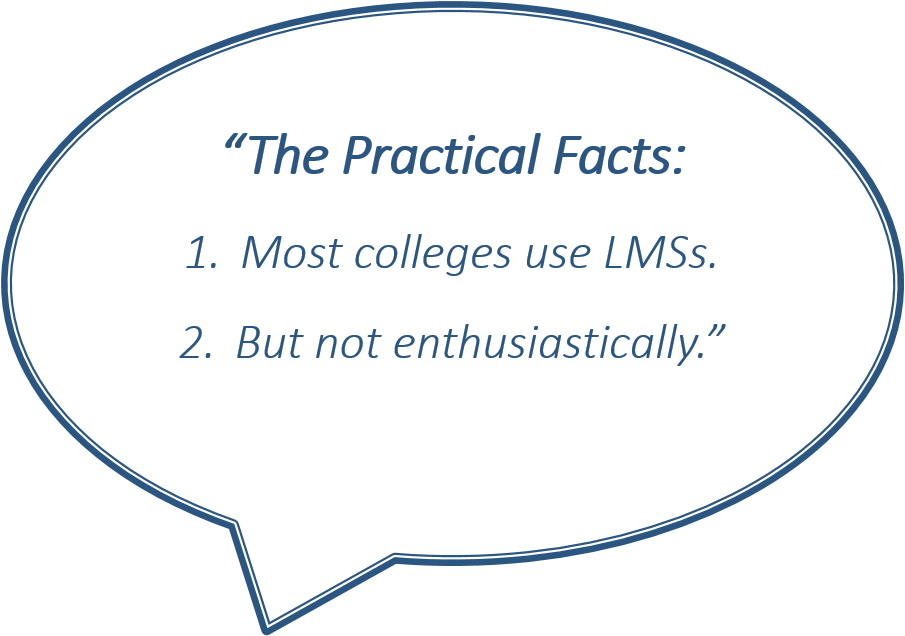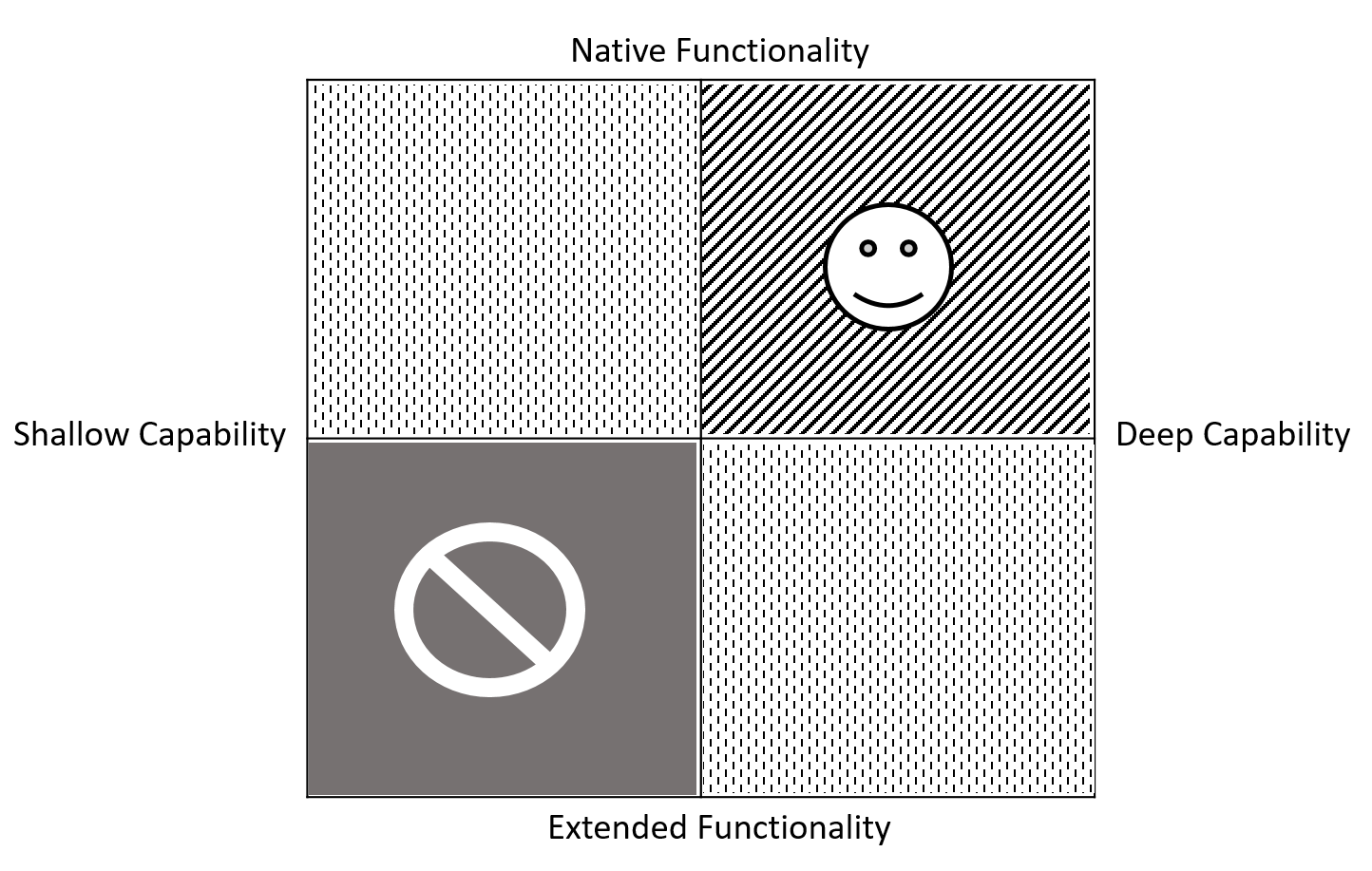In Defense of the LMS
Published by: WCET | 7/20/2017
Tags: LMS, Products And Services, Student Success
Published by: WCET | 7/20/2017
Tags: LMS, Products And Services, Student Success
Many of us have worked with Learning Management System (LMS)s in one way or another, as administrators, instructors, support, assistants, or students. And, through working with these platforms, many of us end up strongly disliking them.
This week we welcome Sasha Thackaberry from Southern New Hampshire University to discuss this love/hate relationship between higher education and LMSs and provide new insights on using the tools in more practical and successful ways.
Enjoy the read!
~Lindsey
Ah, the much-maligned Learning Management System (LMS), the technology we collectively love to hate. It’s often bulky, either feature-bloated or feature-wanting, and has been created seemingly without hiring any user experience designers. For years we’ve been wanting to get rid of it. No one actually likes it. We put up with it. We collectively sigh and move along with our day.
Instead, we propose innovative solutions beyond the LMS—a future learner-centered technology ecosystem that lies just beyond reach wherein we extend a non-LMS platform through rich interoperability. We dream of deploying best-in-class integrated solutions for all of our learning and teaching needs—from basic assignment and assessment management to social interactions,  content curation environments, adaptive learning, Competency-Based Education (CBE) systems and Learning Object Repositories (LOR.) This idealized future has not been largely adopted in higher education, and for good reasons, which we’ll explore later.
content curation environments, adaptive learning, Competency-Based Education (CBE) systems and Learning Object Repositories (LOR.) This idealized future has not been largely adopted in higher education, and for good reasons, which we’ll explore later.
Maybe, instead of hating on this category of technology of admittedly legacy origin, we might try to evolve our ecosystems more practically, both within and beyond the LMS. This defense of the LMS is a proposal for a pragmatic path forward.
The Next Generation Digital Learning Environment (NGDLE) vision proposed by Malcolm Brown, Joanne Dehoney, and Nancy Millichap has been the point of reference for most conversations surrounding this improved, learner-centered technology-enabled future. Other versions of this concept have also been proposed. This concept is based on five domains: interoperability and integration, personalization, analytics, advising and learning assessment, collaboration, and accessibility and universal design. These are really good domains. The NGDLE is a solid and innovative framework from which to view a future, more dynamic learning ecosystem.
Many groups have worked to bring this future closer to reality, like EDUCAUSE through thought leadership, IMS Global through the creation of open interoperability standards, WCET by facilitating the conversation, among others. There have been innovative projects like TEx from the University of Texas System, focusing on a user-centered mobile-based experience, the app store at the University of North Carolina campuses, and systems designed exclusively for CBE like Brainstorm by Ellucian (now closed), Sagence Learning and Fidelis’s LRM solution.
There have even arguably been some success stories regarding a post-LMS world. Western Governors University, for example, has eschewed the LMS in favor of an extended Salesforce platform and usage of curated courseware. However, these examples have still been largely isolated in the marketplace, and have not gained significant traction. It remains that most colleges and universities prefer, at least for the moment, to stick with a traditional LMS. It may be cost, it may be the challenge of overcoming inertia and a  feeling of LMS-related powerlessness, it may be lack of internal development capacity.
feeling of LMS-related powerlessness, it may be lack of internal development capacity.
It may be a lot of things, but the practical fact remains—
One of the things we learned from MOOCs has been that consumer-grade technology can be utilized for learning at scale, for relatively low cost. Even more importantly it can make the learner-as-user experience significantly less painful. The technology should fade into the background. It should support a seamless learning experience wherein the learner takes center stage. Despite the trough of disillusionment that MOOCs are currently experiencing, the fact remains that they are here, they are massive, and learners are voluntarily engaging with them, despite having little skin in the game. The large MOOC engines did hire user experience designers (they arguably should have also hired more instructional designers; a MOOC I am currently taking has immeasurable objectives like “understand”).
Why was this possible? They were freed from the assumptions of legacy systems, and, apart from the cMOOCs (“the originals”) they were largely developed by non-learning specialists who were able to look at the learning environment differently. This is one of the many disruptions of MOOCs, the fallout of which has not yet been fully realized.
Why is there this dissonance between what we in edtech largely agreed was needed decades ago and what has been realized in colleges and universities? Part of this dissonance is a cultural conversation. Engaging in large-scale system changes that involve students and faculty is difficult, time consuming, and expensive. Many institutions do not have adequate funding to cover the cost of simultaneously running two systems while weaning themselves off of the previous one. Most LMS moves in the past five years have been precipitated by the deprecation of other LMSs like Angel and eCollege. At least a few of these changes have been affected by statewide discounts on specific LMSs or other variables like membership in Unizin.
In many cases, the discussions surrounding the NGDLE underestimate the power of status quo in LMS usage patterns. In institutions where the LMS is an add-on to supplement on-ground courses, or wherein online programs have cropped up on an ad hoc basis, it is hard to make the cultural argument for the rest of the institution that the disruption is worth it. Most online courses and programs are still instructor designed and developed; a one-to-many model is not the norm. And in cases where there is a strong online division within a larger institution, there is still the powerful fear of “first, do no harm,” with the perception of opportunity cost for student success being larger than reality.
So what are we to do?
I propose that institutions should evolve the LMS from within. As we undergo such an endeavor, it will be paramount to acknowledge that we are not the users. Learners are the primary users. Faculty are secondary users. And the rest of us should support. Often we have no idea what the user experience really is because we don’t test it, or we don’t ask good enough survey questions to get any actionable data that goes beyond surface inquiries. If we do get actionable data, it is rare that action is actually taken. This proposed pragmatic approach relies upon a consistent focus on the learner-as-user.
There are various functional groupings that are present in the learner-experience first. I will not address here the invisible systems that support the student experience.. Within the learning experience itself there are categories like gradebook management, assignment submission, testing and quizzing, Content Management Systems (CMS,) or preferably Learning Object Repositories (LORs), and content authoring tools. Social engagement tools are needed, as are content curation and collaboration spaces. Outside of the immediate learning environment there are needs such as advising support systems and apps, enrollment activities and bookstore purchasing and provisioning.
All of these functional groupings can be plotted in reference to whether the LMS has those native features or whether the system would need to be extended to support them, and whether the LMS supports that functional grouping in a shallow or deep way. Institutional needs will vary on both spectrums, and conceptualizing of building the NGDLE on an LMS in this way is practical; it has the added benefit of being able to get a better learning environment to learners sooner.
Institutions would then be able to both evaluate LMSs, or other systems, with their needs in mind. If there are functional groupings that a given institution knows they want to use in a deep capacity, that institution may want to look for an LMS that has more of that functionality native to the system in a deeper manner. Likewise if there is lightweight usage, having that feature as a native functionality is a bonus because it is then not necessary to extend it. For needs that may be deeper, and which the LMS does not support natively well, that is where the system would intentionally be extended, preferably through standards-based, plug-and-play integrations, but also through more custom APIs if necessary (quantity and quality of data being both necessary.) Institutions should then avoid like the plague extending their LMS to get shallow functionality, particularly that which is rarely used.

Some institutions still largely utilize their LMS as a document repository and for grades; for online courses this usage expands to the deathly hallows of the discussion boards, for assignment submission and for formative and in some cases summative objective assessments. This relatively shallow usage does not dictate a robust ecosystem, rather it requires a more user-friendly experience. This is a more culturally and fiscally pragmatic approach with which to analyze appropriate systems.
But we still want to get to our ultimate goal—a highly interoperable ecosystem with a best-in-class, learner-as-user experience. Given our current, collective limitations, what are we to do? Instead of searching out alternative platforms, we might partner with LMSs to reconceptualize the LMS as a platform. In many ways, the LMS is already beginning to evolve in this direction. Canvas has their App Store, which is a more individual faculty-driven model. John Baker of D2L recently utilized the oft-referenced Lego analogy. LMSs in general are moving away from individual building blocks or custom integrations towards open standards like LTI, but the robustness of that interoperability is still inconsistent across what version of LTI their product meets. LMSs are integrating more seamless synchronous video functionality – both Canvas and Brightspace have synchronous tools built on Big Blue Button.
An LMS will never out-Twitter Twitter, or out-Facebook Facebook, or indeed even come close to a functional version of those types of social platforms. And they shouldn’t try to. Rather we should work towards interoperability—even of these consumer tools—and do our level best (and more) to respect student data privacy. Putting the selection of input streams and publishing streams into the hands of learners will facilitate the robust nature of the learner-as-user experience.  It will also embed within the educational experience the expectation of a partnership between learning institution and learner, enabling a relationship that will persist beyond graduation and alumni activities as we move to a world where continual education is necessary.
It will also embed within the educational experience the expectation of a partnership between learning institution and learner, enabling a relationship that will persist beyond graduation and alumni activities as we move to a world where continual education is necessary.
This is just the beginning of that evolution. No one likes the walled garden, but there’s not a plausible open playground yet. For many, if not most learners, we need to Chipotle the LMS. We need a core product with flavor options selected by the institution, the faculty or the learner, dependent on institutional model, in an easy-to-use format. (This analogy ignores the recent food contamination issues, though in some cases that might actually be an appropriate analogy in and of itself.)
Standards, standards, standards. Though Caliper, an open standard for measuring learning activity through IMS Global, was released a year and a half ago, there has been limited adoption, most of which can be attributed to the chicken or egg scenario. Those of us who work at higher education institutions need to be the incubators. We need to stand collectively together and, with loud and insistent voices, demand that learning resource vendors and tool providers adhere to more complex standards. We need to ask the same thing of our LMSs. We need to collectively spend our money to make that happen. RFPs need to require adherence to open standards, and the most recent versions of those standards. With purchasing power we can accelerate the development of interoperability.
This interoperability is the critical piece of the NGDLE puzzle. But each institution, depending upon their models for online education, need to evaluate both LMSs and extensible products based on their particular needs and culture. Adoption depends upon culture.
Our options are to either evolve what we have or continue to wait on a future that has not materialized in the years since it was conceptualized. And we can evolve, intentionally, now. An evolution, without the blood of a revolution, can have revolutionary effects for learners. Let’s put our money on that.

Sasha Thackaberry, Ph.D.
Assistant VP, Academic Technology and New Course Models
College of Online and Continuing Education
Southern New Hampshire University
s.thackaberry@snhu.edu

3 replies on “In Defense of the LMS”
[…] for remediation. I recently wrote this article on WCET’s blog: In Defense of the LMS: https://wcet.wiche.edu/frontiers/2017/07/20/in-defense-of-the-lms/. You can gain up to 300 points if you provide me a 800 word analysis of the article noting what […]
Reblogged this on nom@d learning and commented:
Fascinating article by Sasha Thackaberry, Ph.D.
Assistant VP, Academic Technology and New Course Models
College of Online and Continuing Education
Southern New Hampshire University
[…] award for the most popular guest blog this year goes to Sasha Thackaberry for “In Defense of the LMS.” This ended up being a bit of a controversial blog post, as we all received lots of exciting […]